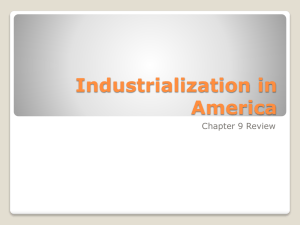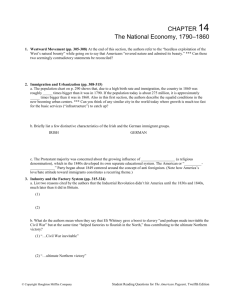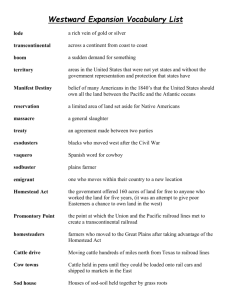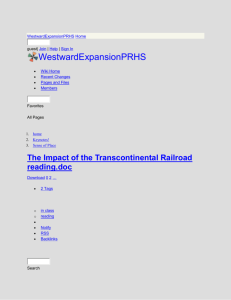Chapter Twenty-Four
advertisement
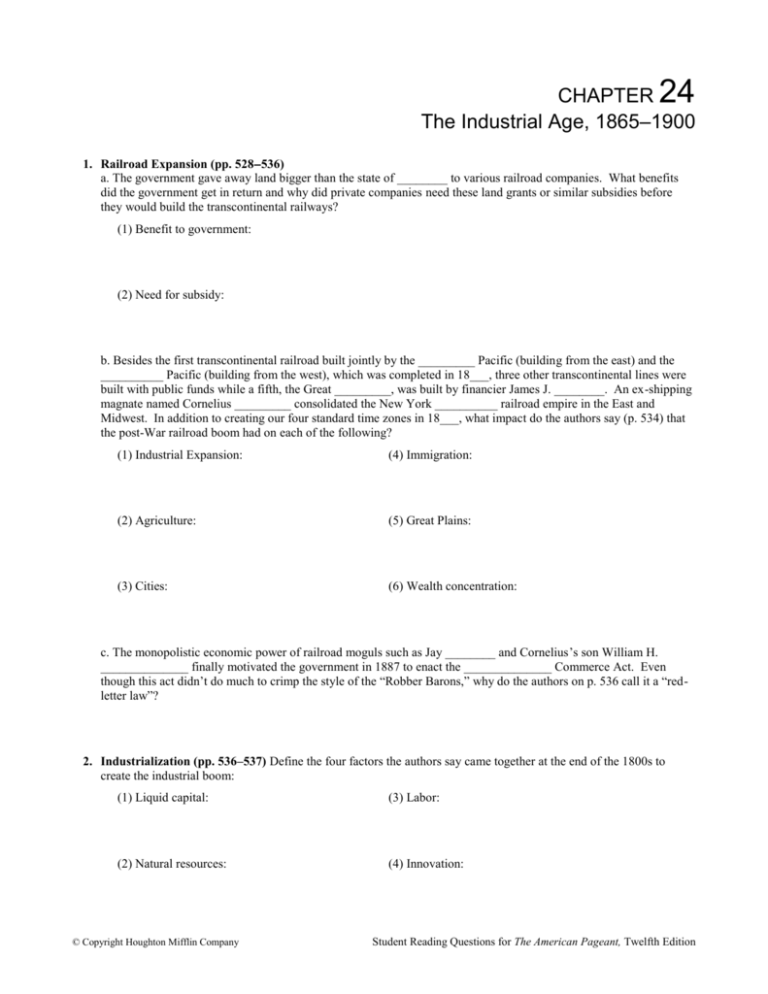
24 CHAPTER The Industrial Age, 1865–1900 1. Railroad Expansion (pp. 528536) a. The government gave away land bigger than the state of ________ to various railroad companies. What benefits did the government get in return and why did private companies need these land grants or similar subsidies before they would build the transcontinental railways? (1) Benefit to government: (2) Need for subsidy: b. Besides the first transcontinental railroad built jointly by the _________ Pacific (building from the east) and the __________ Pacific (building from the west), which was completed in 18___, three other transcontinental lines were built with public funds while a fifth, the Great _________, was built by financier James J. ________. An ex-shipping magnate named Cornelius _________ consolidated the New York __________ railroad empire in the East and Midwest. In addition to creating our four standard time zones in 18___, what impact do the authors say (p. 534) that the post-War railroad boom had on each of the following? (1) Industrial Expansion: (4) Immigration: (2) Agriculture: (5) Great Plains: (3) Cities: (6) Wealth concentration: c. The monopolistic economic power of railroad moguls such as Jay ________ and Cornelius’s son William H. ______________ finally motivated the government in 1887 to enact the ______________ Commerce Act. Even though this act didn’t do much to crimp the style of the “Robber Barons,” why do the authors on p. 536 call it a “redletter law”? 2. Industrialization (pp. 536–537) Define the four factors the authors say came together at the end of the 1800s to create the industrial boom: (1) Liquid capital: (3) Labor: (2) Natural resources: (4) Innovation: © Copyright Houghton Mifflin Company Student Reading Questions for The American Pageant, Twelfth Edition 3. Titans and Trusts (pp. 537–543) a. The steel interests of Andrew _________ are cited as an example of “vertical integration,” while the Standard Oil Trust of John D. _____________ is an example of “horizontal integration.” What is the difference between these two merger forms? (1) Vertical integration: (2) Horizontal integration: b. The financier with the bulbous nose who dominated Wall Street, bought out Carnegie, and formed the U.S. ________ Company was J. P. __________. Rockefeller consolidated what appeared to be a dying petroleum industry that was given new life by the internal-combustion engine used to power the ____________. *** If the “New-Rich” of 100 years ago were concentrated in finance, transportation, and heavy industries, the “New-Rich” of today such as ______________ (name a person) are concentrated in the _______________ industry. c. How were the biological theories of Charles Darwin used (or abused) to rationalize the accumulation of vast wealth by a few and the relative poverty of the masses? d. After the 1887 Interstate Commerce Act, the first government effort to control business excesses was the ___________ Anti-Trust Act of 18___. Though not effectively enforced, it put Congress on record as placing “public need” over “private greed.” *** What’s so bad about a big company monopolizing an industry? Can there be anything good about a monopoly? 4. Impact of Industrialization (pp. 543–549) a. How did industrialization affect the South? b. List three major areas of American life permanently affected by the Industrial Revolution: (1) (2) (3) © Copyright Houghton Mifflin Company Student Reading Questions for The American Pageant, Twelfth Edition 5. Workers and Unions (pp. 549–555) (Note: As you read this section, think of the similar industrial transformations going on today, where older skills are being rapidly replaced by computerized applications.) a. Postwar industrialization changed the nature of work from small units and farms to the regimented factory. This increased real wages, but the income gap between rich and poor was widening at an alarming rate. Unions tried to balance the power of big employers to hire and fire at will and to control working conditions. The _________ of Labor, organized in 18___ under the leadership of Terence V. ___________, was an all-inclusive union, meaning it accepted skilled and unskilled, minorities and whites, women and men. What do the authors say caused this union to lose influence after the violent incident in Chicago’s ___________ Square in 18___? b. The “elitist” ___________ Federation of Labor (AF of L), organized in 18___, was headed by Samuel __________. How did the conservative AF of L differ from the Knights of Labor in each of the following: (1) Membership: (2) Philosophy: VARYING VIEWPOINTS Capitalists and Workers 1. Notice again the loaded terms that we often use to describe people or events. The authors point out here how the same nineteenth-century industrial leaders have been called everything from “Captains of Industry” to “Robber Barons.” After reading this chapter, how would you characterize people like Carnegie, Rockefeller, Vanderbilt, and Morgan? 2. The labor movement in Europe, reacting to many of the same industrial conditions found in America, has been much more heavily based on class considerations - i.e., the working class versus the capitalist class. It has tended to be more Marxist and socialist in orientation - i.e., looking to overthrow the capitalist system of private ownership of the means of production as opposed to simply trying to secure better terms for the working person within the existing capitalist system. *** After reading the “Varying Viewpoints” essay, do you have any ideas as to why the American labor movement has been less revolutionary and more accepting of the underlying capitalist structure? © Copyright Houghton Mifflin Company Student Reading Questions for The American Pageant, Twelfth Edition CHAPTER 24 TERM SHEET The Industrial Age Pages 528–536 Union Pacific Railroad Crédit Mobilier Central Pacific Railroad The “Big Four” Transcontinental Line (1869) Northern Pacific Railroad (1883) Atchison, Topeka, and Santa Fe Railroad (1884) Southern Pacific Railroad (1884) Great Northern Railroad (1893) James J. Hill New York Central “Commodore” Cornelius Vanderbilt “Time zones” (1883) Jay Gould “Stock watering” “Pool” arrangements Wabash case (1886) Interstate Commerce Act (1887) Interstate Commerce Commission (ICC) Pages 536–537 Alexander Graham Bell Thomas A. Edison Pages 537–543 Andrew Carnegie John D. Rockefeller J. P. Morgan © Copyright Houghton Mifflin Company Student Reading Questions for The American Pageant, Twelfth Edition “Vertical integration” “Horizontal integration” “Trust” Standard Oil Trust “Interlocking directorates “ Bessemer process United States Steel Corp. (1901) Gustavus Swift/Philip Armour “Gospel of Wealth” “Social Darwinism” Sherman Anti-Trust Act (1890) Pages 543–549 James Buchanan Duke The “New South” “Pittsburgh plus” pricing “Gibson girl” Pages 549–555 “Scabs” “Lockout” “Yellow-dog contracts” “Black list” National Labor Union (1866) Knights of Labor (1869) Terence Powderly Haymarket Square episode (1886) American Federation of Labor (AF of L) (1886) Samuel Gompers “Mother” Jones © Copyright Houghton Mifflin Company Student Reading Questions for The American Pageant, Twelfth Edition


